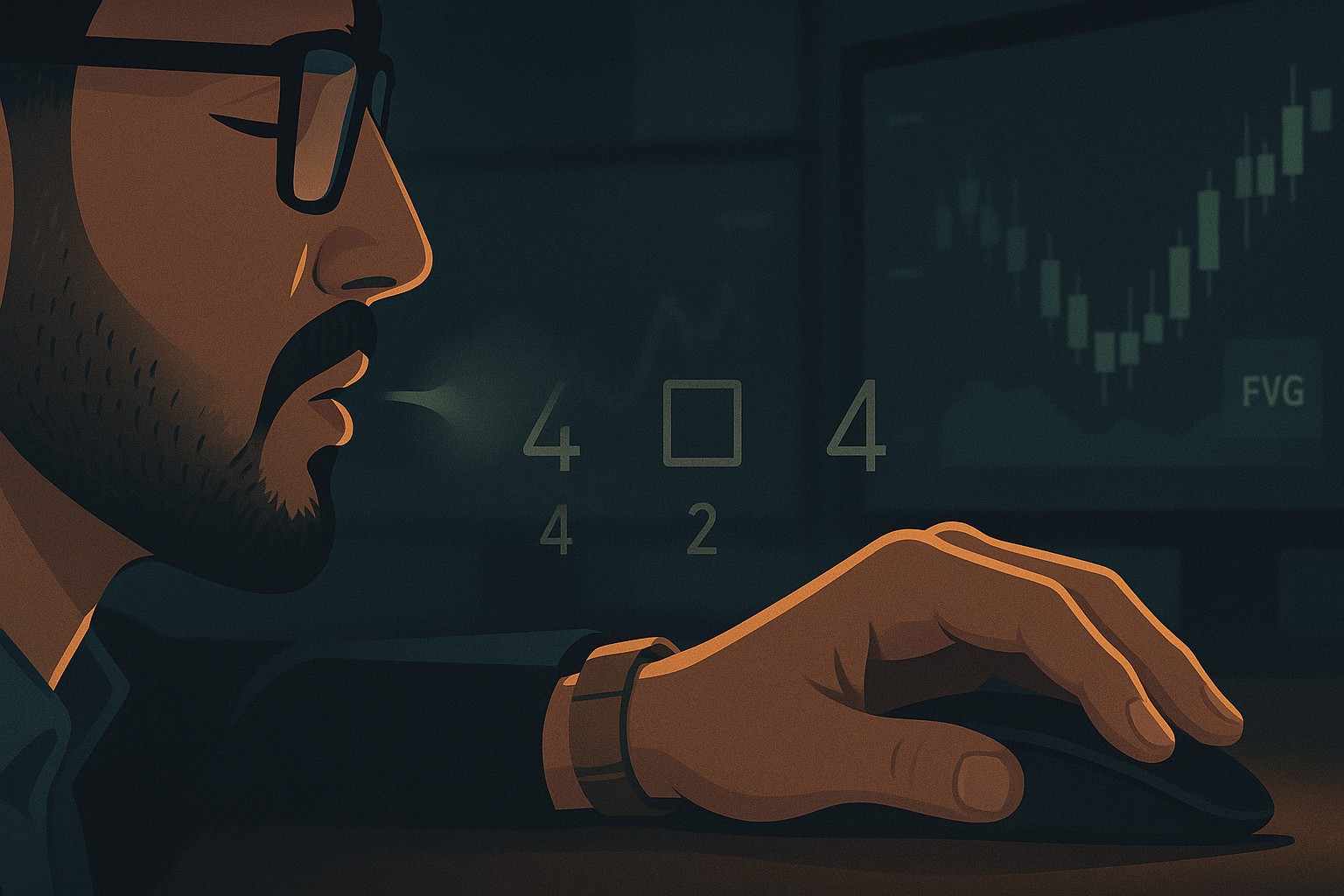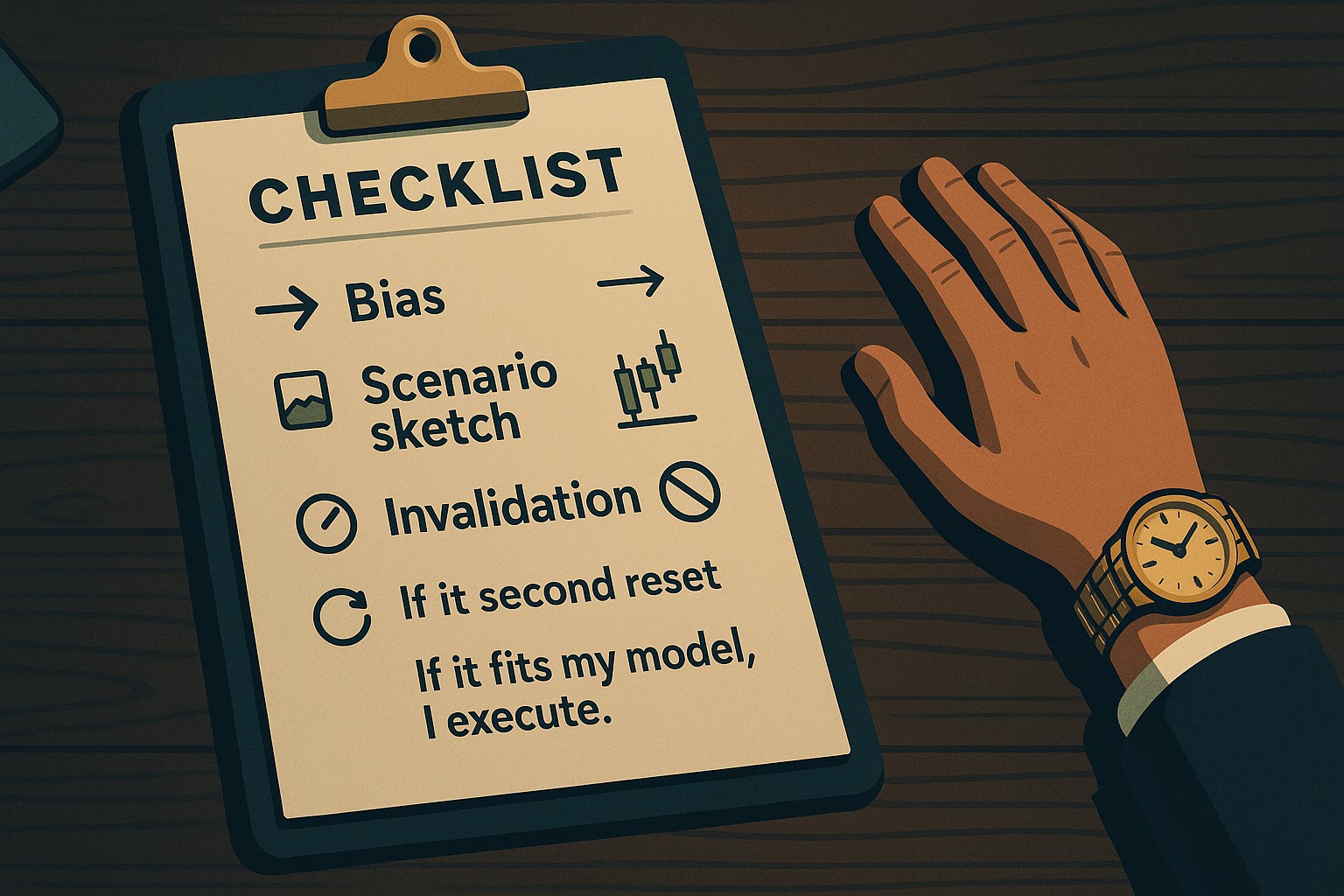Execution Psychology: Turning Hesitation into Confidence
2025-10-28 10:16:34
When the Chart Is Clear but the Mind Isn’t

You’ve seen it unfold perfectly - a clean sweep of liquidity, a sharp displacement candle confirming bias, and a Fair Value Gap (FVG) waiting like a doorway into precision. Yet your hand hesitates. Your finger trembles over the mouse. You breathe, you stare, and before you act - the price runs away without you.
That’s not a technical mistake. That’s execution paralysis - the emotional lag between clarity and conviction.
Most traders assume their problem lies in strategy or timing, but more often it’s psychological. Execution psychology is the unseen discipline of trading: the art of acting decisively under uncertainty. It’s where technical mastery meets emotional control. And until you master it, even the perfect setup will slip through your fingers.
The Science Behind the Freeze

When you’re about to enter a trade, your brain doesn’t see “potential profit.” It sees risk - uncertainty that could lead to loss or regret.
This triggers your amygdala - the same survival center that activates during real physical danger. Your heart rate rises. Your palms sweat. Breathing shortens. The very organ you rely on to make high-quality decisions - your prefrontal cortex - starts to shut down.
You’re not scared of the chart. You’re scared of the outcome.
That’s why seasoned traders use pre-entry conditioning - a structured sequence to calm the body and clear the mind before clicking “Buy” or “Sell.” Pair it with a fast mechanical confirmation so your brain stops searching for emotional safety and follows the model. If you don’t have a rule-set yet, steal one from this step-by-step confirmation guide.
Here’s a simple yet powerful 10-second routine you can do before every trade:
- Exhale deeply for four seconds. Let tension exit your system.
- Hold for two seconds. Create a pause between impulse and intention.
- Inhale through the nose for four seconds. Refill with control.
- Repeat once. Then execute according to your checklist.
You’ve just taken control of your physiology - and by extension, your psychology.
This isn’t “breathing for calm.” It’s breathing for clarity. It signals to your nervous system: I’m safe. I’m in control.
The next time you’re about to hesitate, remember - confidence isn’t the absence of fear. It’s the ability to act while fear is present.
Controlled Aggression: The Antidote to Hesitation

Hesitation in trading feels logical - “Maybe it’ll retest one more time,” “Let’s wait for confirmation,” or “I’ll enter if the next candle closes bullish.”
But underneath that logic is fear disguised as patience.
True execution confidence is what elite traders call controlled aggression - the ability to strike decisively when your data-backed model confirms the move.
In Smart Money Concepts (SMC), hesitation often happens right when the market is doing what it’s supposed to do:
- A liquidity sweep looks like a breakout trap.
- An FVG retest pierces a little deeper than expected.
- A Market Structure Shift (MSS) comes one candle later than you planned.
This is where the amateur freezes, but the professional executes - because conviction was decided before the setup appeared.
Controlled aggression is not recklessness; it’s trust in preparation.
It’s knowing that every setup you take aligns with a backtested rule, a structured risk, and an emotional acceptance of loss. You don’t “hope” it works; you allow it to play out.
If you need a clean execution blueprint, study the walkthrough in Anatomy of a Perfect Execution here: trade with precision.
One of the simplest mental scripts to use before you execute is:
“I don’t control the outcome. I control the process.”
By detaching from the result, your brain stops trying to protect your ego - and starts serving your system.
The Art of Presence: Staying Composed After Entry

The challenge doesn’t end when you click “Buy.” In fact, that’s when the real battle begins.
You start watching every tick, every candle shadow, every minor fluctuation - and suddenly you’re not following your plan anymore; you’re reacting emotionally to noise.
Execution psychology continues after entry through presence and breath regulation.
Here’s what that looks like in practice:
- During drawdown: Exhale longer than you inhale. This activates the parasympathetic nervous system - your body’s natural “brake.”
- When in profit: Maintain steady breathing. Excitement can distort perception and cause premature exits.
- At breakeven: Breathe rhythmically, not reactively. You’re observing data, not emotions.
Every breath you control is one less impulsive action you’ll regret. Want a structured approach to staying systematic during trends and pullbacks? Keep a simple anchor like the Moving Averages Playbook nearby to avoid micromanaging every tick.
Traders often ask, “How do I hold longer?” The answer is simple but profound - breathe through discomfort instead of reacting to it.
Real-Life Analogy: The Archer’s Calm
Think of a professional archer in competition. They draw the bow, align their sight, and breathe - not because they’re waiting for perfection, but because calm precision is the trigger.
The shot doesn’t happen in excitement. It happens in silence.
Trading is the same art form.
Your “bow” is your system, your “arrow” is your entry, and your “target” is the setup. You don’t fire when emotions peak; you fire when your breathing slows and your vision narrows to the model.
The archer doesn’t chase the bullseye - he trusts the process. The moment he overthinks the target, the shot misses.
In trading, that’s what hesitation is - overthinking in the moment of truth.
The Ritual: Training Your Mind for Automatic Confidence

Every elite performer - athlete, soldier, or trader - relies on rituals.
Why? Because rituals reduce the cognitive load of decision-making. They train your nervous system to feel safe in familiar patterns, even under stress.
Create a pre-market and pre-entry ritual that grounds you:
Morning Routine:
- Review your bias and session plan. A quick refresher on multi-timeframe analysis helps align H1 with your execution timeframe.
- Visualize one or two scenarios - not ten.
- Stretch or walk briefly to regulate breathing.
- Journal how you feel - anxious, confident, distracted. Use a structure like The Trader’s Mirror.
Pre-Trade Ritual:
Reconfirm your execution model (e.g., liquidity grab → displacement → FVG).
Identify invalidation points and expected structure.
Perform the 10-second breathing reset.
Say this aloud:
“If it fits my model, I execute without hesitation.”
This simple habit rewires your brain through repetition and self-command.
The more you do it, the more your mind associates structure with safety - until decisive action becomes instinct, not effort.
If you trade indices, ritualize time-based conviction as well. For example, restrict first shots to the first 30 minutes and use this guide to anchor your routine at the open: scalp indices at the open.
The Hidden Cost of Hesitation
Let’s talk numbers.
Every time you hesitate and miss a valid setup, the market doesn’t just take your opportunity - it taxes your emotional capital.
That lingering frustration? That’s your psychological drawdown. And just like financial drawdowns, it compounds over time.
You begin second-guessing the next trade. You tweak your model unnecessarily. You enter too late on the next setup, only to be stopped out where your original entry would’ve won.
Execution hesitation isn’t harmless - it’s the silent leak in your consistency bucket.
And the cure isn’t “more confidence.” It’s more clarity and repetition.
Ground your execution inside a risk-first box so losses don’t shake you: stop placement, target mapping, and size - all decided before entry. If you need a refresher, tighten up with this risk management primer.
Real Application: During Liquidity Grabs or FVG Retests
Let’s put this into the market context.
You’re trading Nasdaq at the US open. The previous high gets swept - your liquidity model is in play. Price displaces lower, leaving an M5 FVG. You know the rules: wait for a return, confirm structure, execute.
But price pulls back fast - deep into the gap - and your pulse spikes. “Maybe it’s invalid.”
You hesitate, wait for “one more candle”… and then it drops 80 points without you.
What happened?
You didn’t lack knowledge. You lacked execution trust.
The correct behavior here is preconditioned calmness:
- You breathe, check displacement alignment with the higher timeframe.
- The plan remains intact.
- You execute on the trigger because your edge was defined before the chaos.
If you struggle to separate patience from fear, revisit the mental side here: the mental game of execution. And if FOMO or revenge knocks after a miss, reset with this short clinic on stopping emotional trading.
When you act from structure, uncertainty doesn’t scare you - it guides you.
Final Thoughts: Conviction Under Pressure

Execution is not about finding perfection - it’s about mastering yourself when perfection fails to appear.
The difference between an average and a consistent trader is not how much they know, but how decisively they act when it matters most.
When you hesitate, the market moves on. But when you execute with structure, even a loss reinforces discipline. And that’s where long-term confidence grows - not from winning every trade, but from acting with alignment every time.
Remember this:
“Conviction is not the absence of fear - it’s the decision to act despite it.”
Your system gives you logic.
Your execution gives you power.
Together, they make you unstoppable.
Challenge for This Week
Before every trade, do your 10-second breathing protocol and record your pre-entry clarity in your journal from 1–10.
At the end of the week, review your scores. You’ll start noticing a pattern - your best trades didn’t come from excitement or intuition; they came from calm aggression under structure.
FAQ
1. How do I know if I’m hesitating or waiting for confirmation?
If all your setup criteria are met and you still delay due to “what ifs,” it’s hesitation. Confirmation should be mechanical, not emotional - use a simple matrix like the one in the guide above.
2. What if I start overtrading after fixing hesitation?
That’s a pendulum effect. Calm down, re-center with your breathing ritual, and only execute trades that align with your rule-based checklist.
3. How can I use breathing to improve discipline?
Slow breathing stabilizes the vagus nerve - it reduces adrenaline, sharpens focus, and restores logical reasoning.
4. How can I train execution confidence outside of trading?
Through micro-decisions: waking up without snoozing, finishing a workout rep, saying no to impulses. Small acts of follow-through build execution muscles.
Start Practicing with Confidence - Risk-Free!
- Trade forex, indices, gold, and more
- Access ACY, MT4, MT5, & Copy Trading Platforms
- Practice with zero risk
It’s time to go from theory to execution - risk-free.
Create an Account. Start Your Free Demo!
Check Out My Contents:
Strategies That You Can Use
Looking for step-by-step approaches you can plug straight into the charts? Start here:
- How To Trade & Scalp Indices at the Open Using Smart Money Concepts (SMC)
- How to Trade Breakouts Effectively in Day Trading with Smart Money Concepts
- Complete Step-by-Step Guide to Day Trading Gold (XAU/USD) with Smart Money Concepts (SMC)
- The Power of Multi-Timeframe Analysis in Smart Money Concepts (SMC)
- Forex Trading Strategy for Beginners
- Mastering Candlestick Pattern Analysis with the SMC Strategy for Day Trading
- How to Use Fibonacci to Set Targets & Stops (Complete Guide)
- RSI Divergence Trading Strategy for Gold: How to Identify and Trade Trend Reversals
- Stochastics Trading Secrets: How to Time Entries in Trending Markets using Stochastics
- Gold Trading Stochastics Strategy: How to Trade Gold with 2R - 3R Targets
- RSI Hidden Divergence Explained: How to Spot Trend Continuations Like a Pro
- Moving Averages Trading Strategy Playbook
- Mastering Fibonacci Trading Psychology - Trusting the Levels, Managing the Mind
- Mastering Price Action at Key Levels - How to Spot, Trade, and Win at the Most Crucial Zones
- Mastering Retests: How to Enter with Confirmation After a Breakout
Indicators / Tools for Trading
Sharpen your edge with proven tools and frameworks:
- The Ultimate Guide to Risk Management in Trading - A Complete Compilation for 2025
- Moving Averages Trading Strategy Playbook
- How to Think Like a Price Action Trader
- Mastering Fibonacci Trading Psychology - Trusting the Levels, Managing the Mind
How To Trade News
News moves markets fast. Learn how to keep pace with SMC-based playbooks:
- Why Smart Money Concepts Work in News-Driven Markets - CPI, NFP, and More
- How to Trade NFP Using Smart Money Concepts (SMC) - A Proven Strategy for Forex Traders
- How to Trade CPI Like Smart Money - A Step-by-Step Guide Using SMC
Learn How to Trade US Indices
From NASDAQ opens to DAX trends, here’s how to approach indices like a pro:
- How to Start Trading Indices and Get into the Stock Market with Low Capital (2025 Guide)
- Best Indices to Trade for Day Traders | NASDAQ, S&P 500, DAX + Best Times to Trade Them
- How To Trade & Scalp Indices at the Open Using Smart Money Concepts (SMC)
- NAS100 - How to Trade the Nasdaq Like a Pro (Smart Money Edition)
How to Start Trading Gold
Gold remains one of the most traded assets - here’s how to approach it with confidence:
- How to Swing Trade Gold (XAU/USD) Using Smart Money Concepts: A Simple Guide for Traders
- Complete Step-by-Step Guide to Day Trading Gold (XAU/USD) with Smart Money Concepts (SMC)
- The Ultimate Guide to Backtesting and Trading Gold (XAU/USD) Using Smart Money Concepts (SMC)
- Why Gold Remains the Ultimate Security in a Shifting World
- How to Exit & Take Profits in Trading Gold Like a Pro: Using RSI, Range Breakdowns, and MAs as Your Confluence
How to Trade Japanese Candlesticks
Candlesticks are the building blocks of price action. Master the most powerful ones:
- Mastering the Top Japanese Candlesticks: The Top 5 Candlesticks To Trade + Top SMC Candlestick Pattern
- How to Trade Candlestick Patterns with High Probability: A Complete Guide for Beginners
- The Top Japanese Candlestick Guide: What is an Engulfing Pattern and How to Trade It?
- Piercing Pattern Candlestick Explained: How to Trade It - Step-By-Step Guide
- Morning & Evening Star Candlestick Patterns - How to Trade Market Reversals with Confidence
How to Start Day Trading
Ready to go intraday? Here’s how to build consistency step by step:
- 5 Steps to Start Day Trading: A Strategic Guide for Beginners
- 8 Steps How to Start Forex Day Trading in 2025: A Beginner’s Step-by-Step Guide
- 3 Steps to Build a Trading Routine for Consistency and Discipline - Day Trading Edition
- The Ultimate Guide to Understanding Market Trends and Price Action
- Trading with Momentum: The Best Trading Session to Trade Forex, Gold and Indices
Swing Trading 101
- Introduction to Swing Trading
- The Market Basics for Swing Trading
- Core Principles of Swing Trading
- The Technical Foundations Every Swing Trader Must Master
- Swing Trader’s Toolkit: Multi-Timeframe & Institutional Confluence
- The Psychology of Risk Management in Swing Trading
- Swing Trading Concepts To Know In Trading with Smart Money Concepts
- Becoming a Consistent Swing Trader: Trading Structure & Scaling Strategy
Learn how to navigate yourself in times of turmoil
Markets swing between calm and chaos. Learn to read risk-on vs risk-off like a pro:
- How to Identify Risk-On and Risk-Off Market Sentiment: A Complete Trader’s Guide
- How to Trade Risk-On and Risk-Off Sentiment - With Technical Confirmation
- The Ultimate Guide to Understanding Market Trends and Price Action
- Metals in Risk-On and Risk-Off Environments: How Sentiment Moves Gold and Commodities
Want to learn how to trade like the Smart Money?
Step inside the playbook of institutional traders with SMC concepts explained:
- Why Smart Money Concepts Work: The Truth Behind Liquidity and Price Action
- Mastering the Market with Smart Money Concepts: 5 Strategic Approaches
- Understanding Liquidity Sweep: How Smart Money Trades Liquidity Zones in Forex, Gold, US Indices
- The SMC Playbook Series Part 1: What Moves the Markets? Key Drivers Behind Forex, Gold & Stock Indices
- The SMC Playbook Series Part 2: How to Spot Liquidity Pools in Trading - Internal vs External Liquidity Explained
- Fair Value Gaps Explained: How Smart Money Leaves Footprints in the Market
- Accumulation, Manipulation, Distribution: The Hidden Cycle That Runs Every Market
- Institutional Order Flow - Reading the Market Through the Eyes of the Big Players
- London Session Trading Secrets: How Smart Money Sets the High & Low of the Day
- Mastering the New York Session - Smart Money Concepts Guide
- Anatomy of a Perfect Execution: How SMC Traders Trade with Precision
- Step-by-Step Trading Confirmation Guide for Precise Execution
Master the World’s Most Popular Forex Pairs
Forex pairs aren’t created equal - some are stable, some are volatile, others tied to commodities or sessions.
- The Top 5 All-Time Best Forex Pairs to Trade
- Top Forex Pairs Beyond the Big Five
- EUR/USD: The King of Forex
- USD/JPY: The Fast Mover
- GBP/USD: The Volatile Cable
- AUD/USD: The Commodity Currency
- USD/CAD: The Oil-Backed Pair
- GBP/JPY: How to Trade The Beast
- Asian & London Session Secrets
- Mastering the New York Session
Metals Trading
- Metals Trading: Why Gold and Metals Are Rising Again
- Silver Trading: The Underdog with Dual Identity
- Gold vs Silver: Institutional Demand Breakdown Explained
- Platinum & Palladium: The Quiet Power Duo of Industrial Metals
- How to Trade Metals with SMC and Fundamentals - Gold Trading Strategy
- Future of Metals Market: Gold Forecast 2026 & Long-Term Commodities Outlook
Stop Hunting 101
If you’ve ever been stopped out right before the market reverses - this is why:
- Stop Hunting 101: How Swing Highs and Lows Become Liquidity Traps
- Outsmarting Stop Hunts: The Psychology Behind the Trap
- How to Lessen Risk From Stop Hunts in Trading
- How Stop Hunts Trigger Revenge Trading - Breaking the Pain Cycle
- How to Accept Stop Hunts Without Losing Discipline - Shifting From Frustration to Focus
Trading Psychology
Mindset is the deciding factor between growth and blowups. Explore these essentials:
- The Mental Game of Execution - Debunking the Common Trading Psychology
- Managing Trading Losses: Why You Can Be Wrong and Still Win Big in Trading
- The Hidden Threat in Trading: How Performance Anxiety Sabotages Your Edge
- Why 90% of Retail Traders Fail Even with Profitable Trading Strategies
- Top 10 Habits Profitable Traders Follow Daily to Stay Consistent
- Top 10 Trading Rules of the Most Successful Traders
- Top 10 Ways to Prevent Emotional Trading and Stay Disciplined in the Markets
- Why Most Traders Fail - Trading Psychology & The Hidden Mental Game
- Emotional Awareness in Trading - Naming Your Triggers
- Discipline vs. Impulse in Trading - Step-by Step Guide How to Build Control
- Trading Journal & Reflection - The Trader’s Mirror
- Overcoming FOMO & Revenge Trading in Forex - Why Patience Pays
- Risk of Ruin in Trading - Respect the Math of Survival
- Identity-Based Trading: Become Your Trading System for Consistency
- Trading Psychology: Aligning Emotions with Your System
- Mastering Fear in Trading: Turn Doubt into a Protective Signal
- Mastering Greed in Trading: Turn Ambition into Controlled Growth
- Mastering Boredom in Trading: From Restless Clicking to Patient Precision
- Mastering Doubt in Trading: Building Confidence Through Backtesting and Pattern Recognition
- Mastering Impatience in Trading: Turn Patience Into Profit
- Mastering Frustration in Trading: Turning Losses Into Lessons
- Mastering Hope in Trading: Replacing Denial With Discipline
- When to Quit on Trading - Read This!
- The Math of Compounding in Trading
- Why Daily Wins Matter More Than Big Wins
- Scaling in Trading: When & How to Increase Lot Sizes
- Why Patience in Trading Fuels the Compounding Growth
- Step-by-Step Guide on How to Manage Losses for Compounding Growth
- The Daily Habits of Profitable Traders: Building Your Compounding Routine
- Trading Edge: Definition, Misconceptions & Casino Analogy
- Finding Your Edge: From Chaos to Clarity
- Proving Your Edge: Backtesting Without Bias
- Forward Testing in Trading: How to Prove Your Edge Live
- Measuring Your Edge: Metrics That Matter
- Refining Your Edge: Iteration Without Overfitting
- The EDGE Framework: Knowing When and How to Evolve as a Trader
- Scaling Your Edge: From Small Account to Consistency
Market Drivers
- Central Banks and Interest Rates: How They Move Your Trades
- Inflation & Economic Data: CPI Trading Strategy and PPI Indicator Guide
- Geopolitical Risks & Safe Havens in Trading (Gold, USD, JPY, CHF)
- Jobs, Growth & Recession Fears: NFP, GDP & Unemployment in Trading
- Commodities & Global Trade: Oil, Gold, and Forex Explained
- Market Correlations & Intermarket Analysis for Traders
Risk Management
The real edge in trading isn’t strategy - it’s how you protect your capital:
- Mastering Risk Management: Stop Loss, Take Profit, and Position Sizing
- Why Risk Management Is the Only Edge That Lasts
- How Much Should You Risk per Trade? (1%, 2%, or Less?)
- The Ultimate Risk Management Plan for Prop Firm Traders - Updated 2025
- Mastering Position Sizing: Automate or Calculate Your Risk Like a Pro
- Martingale Strategy in Trading: Compounding Power or Double-Edged Sword?
- How to Add to Winners Using Cost Averaging and Martingale Principle with Price Confirmation
Suggested Learning Path
If you’re not sure where to start, follow this roadmap:
- Start with Trading Psychology → Build the mindset first.
- Move into Risk Management → Learn how to protect capital.
- Explore Strategies & Tools → Candlesticks, Fibonacci, MAs, Indicators.
- Apply to Assets → Gold, Indices, Forex sessions.
- Advance to Smart Money Concepts (SMC) → Learn how institutions trade.
- Specialize → Stop Hunts, News Trading, Turmoil Navigation.
This way, you’ll grow from foundation → application → mastery, instead of jumping around randomly.
Follow me for more daily market insights!
Jasper Osita - LinkedIn - FXStreet - YouTube
This content may have been written by a third party. ACY makes no representation or warranty and assumes no liability as to the accuracy or completeness of the information provided, nor any loss arising from any investment based on a recommendation, forecast or other information supplies by any third-party. This content is information only, and does not constitute financial, investment or other advice on which you can rely.
Try These Next
4 Powerful Tactics to Overcome the Most Costly Forex Mistakes
How to Master MT4 & MT5 - Tips and Tricks for Traders
The Importance of Fundamental Analysis in Forex Trading
Forex Leverage Explained: Mastering Forex Leverage in Trading & Controlling Margin
The Importance of Liquidity in Forex: A Beginner's Guide
Close All Metatrader Script: Maximise Your Trading Efficiency and Reduce Stress
Best Currency Pairs To Trade in 2025
Forex Trading Hours: Finding the Best Times to Trade FX
MetaTrader Expert Advisor - The Benefits of Algorithmic Trading and Forex EAs
Top 5 Candlestick Trading Formations Every Trader Must Know















